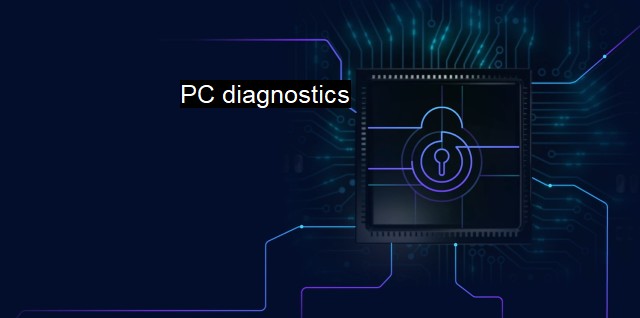What are PC diagnostics?
The Importance of PC Diagnostics in Cybersecurity and Antivirus: Identifying and Protecting Computer Systems from Threats
PC diagnostics is a system procedure that testifies the operation, functionality, and performance of software and hardware components of a computer system. The art of diagnosing a system on a Personal Computer is to ascertain its overall performance standard. PC diagnostics are an essential subset particularly aimed at identifying problems inhibiting the smooth running and operation of the computer system.In the world of cybersecurity and antivirus defense, PC diagnostics takes a unique turn being one of the first lines of defense against malicious software and cyber-attacks. Harnessing the strength of diagnostic tools, cybersecurity professionals locate system vulnerabilities, track the operational health and evaluate the defenses to enhance their protection measures.
For instance, the computer may at times act sluggishly, run out of the disk capacity without ample explanation, or experience irregularities in system function. In such scenarios, PC diagnostics can highlight potential issues influencing such behavior. Either it may point out a corrupted file that is dragging down the system operation or detect breaches in security walls that have allowed malware invasion.
In the cybersecurity context, PC diagnostics incorporates a wide range of checks. Included are checks such as malware scanning, ensuring firewalls are correctly configured and operational, verifying software is updated to recent versions. These checks and more are all geared toward recognizing and rectifying issues that might affect the computer's security integrity.
Malware scanning, a critical diagnostic process, ensures that the computer is free from viruses, Trojans, ransomware, or any malicious software that can corrupt or steal data. It also identifies suspicious behaviors indicating potential threats.
Next could be firewall assessment. Firewalls form a critical barrier between the computer network and external threats, making firewall evaluation part of PC diagnostics within the cybersecurity context. Diagnostic tools can verify the firewall's operational status, ensuring it's properly screening incoming and outgoing traffic.
Software verification is another essential provision of PC diagnostics. Cyber attackers often exploit outdated software to breach system defenses by taking advantage of known vulnerabilities from earlier editions. Hence, regular checking to ensure or confirm all software on the PC system is up to date is critical.
Through these system check-ups, antiviruses function in an increasingly potent manner. They offer real-time defense against potential harms, stopping them even before they inflict system damage. Although diagnostic procedures differ from one antivirus software to another, the core goal remains the same: to identify problems and rectify them.
Most antivirus software comes with built-in PC diagnostics to enhance their protective features. Such diagnostic checks help in identifying suspicious runtime behaviors, corrupted system files, critically evaluating installed software for potential vulnerabilities, and overseeing the system's overall operational health note.
PC diagnostics can prioritize how issues discovered should be addressed. When multiple problems are discovered, diagnostic tools evaluate each for urgency, determining their potential impact on the computer's performance and overall security. This is critical in the cybersecurity context because it allows for immediate action in addressing high-priority issues.
Everything from detection of hidden spyware, removal of junk files, close-down of unnecessary background applications to recommending updates to the firewall configuration or indicating a requirement for browser updates fall under this same umbrella of PC diagnostics.
PC diagnostics within the context of cybersecurity and antivirus operations assist in the identification and mitigation of potential risks and threats facing a computer system. They serve a preventative role, identifying problems before they escalate into significant issues that could derail the optimal functioning of the system. They also contribute towards a safer, secure online environment and maintain the fluency and fluidity in the functionality of computers.

PC diagnostics FAQs
What is PC diagnostics and how does it help in cybersecurity?
PC diagnostics is a process of identifying, analyzing, and resolving issues and errors in the computer system. It helps in maintaining the optimal performance of the system and protecting it from cyber threats. By performing regular diagnostics, users can identify security vulnerabilities in their system and take appropriate measures to secure it.What are the benefits of performing PC diagnostics in terms of antivirus software?
PC diagnostics can help in identifying issues and errors in antivirus software, such as outdated virus definitions, malfunctioning antivirus features, and conflicts with other security programs. By diagnosing these problems, users can resolve them quickly and ensure that their antivirus software is functioning properly to protect their system from malware and other cyber threats.What are some common PC diagnostic tools used in cybersecurity?
There are several PC diagnostic tools used in cybersecurity, such as system information tools, software and hardware analyzers, registry cleaners, and antivirus scanners. These tools help in detecting and resolving issues related to software, hardware, and security systems.How frequently should PC diagnostics be performed for cybersecurity purposes?
PC diagnostics should be performed regularly, at least once a month, to ensure that the system is functioning optimally and protected from cyber threats. However, if users experience any unusual system behavior or suspect a security breach, they should perform diagnostics immediately to identify and resolve any issues.| | A | | | B | | | C | | | D | | | E | | | F | | | G | | | H | | | I | | | J | | | K | | | L | | | M | |
| | N | | | O | | | P | | | Q | | | R | | | S | | | T | | | U | | | V | | | W | | | X | | | Y | | | Z | |
| | 1 | | | 2 | | | 3 | | | 4 | | | 7 | | | 8 | | |||||||